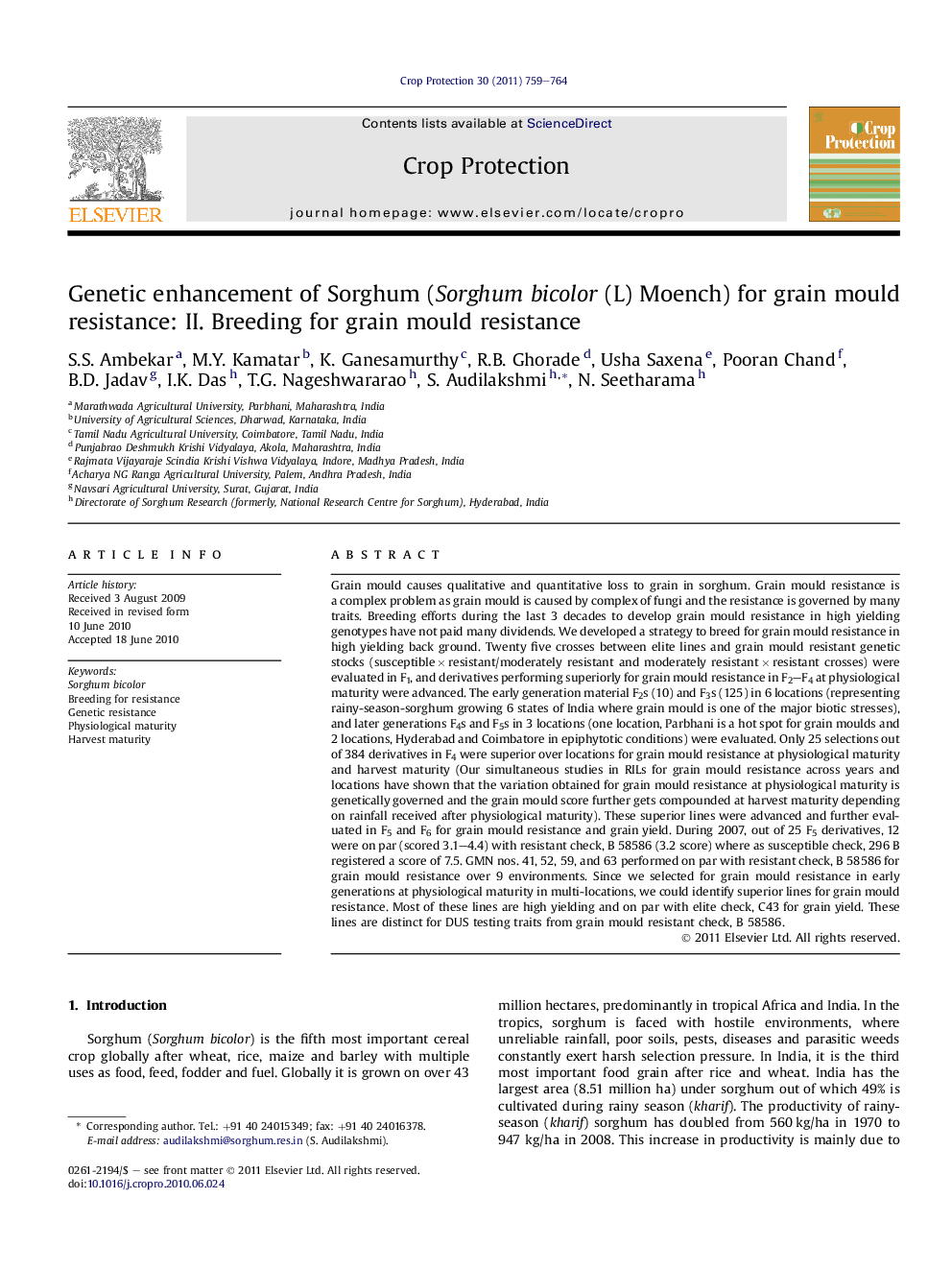| کد مقاله | کد نشریه | سال انتشار | مقاله انگلیسی | نسخه تمام متن |
|---|---|---|---|---|
| 4506858 | 1321333 | 2011 | 6 صفحه PDF | دانلود رایگان |

Grain mould causes qualitative and quantitative loss to grain in sorghum. Grain mould resistance is a complex problem as grain mould is caused by complex of fungi and the resistance is governed by many traits. Breeding efforts during the last 3 decades to develop grain mould resistance in high yielding genotypes have not paid many dividends. We developed a strategy to breed for grain mould resistance in high yielding back ground. Twenty five crosses between elite lines and grain mould resistant genetic stocks (susceptible × resistant/moderately resistant and moderately resistant × resistant crosses) were evaluated in F1, and derivatives performing superiorly for grain mould resistance in F2–F4 at physiological maturity were advanced. The early generation material F2s (10) and F3s (125) in 6 locations (representing rainy-season-sorghum growing 6 states of India where grain mould is one of the major biotic stresses), and later generations F4s and F5s in 3 locations (one location, Parbhani is a hot spot for grain moulds and 2 locations, Hyderabad and Coimbatore in epiphytotic conditions) were evaluated. Only 25 selections out of 384 derivatives in F4 were superior over locations for grain mould resistance at physiological maturity and harvest maturity (Our simultaneous studies in RILs for grain mould resistance across years and locations have shown that the variation obtained for grain mould resistance at physiological maturity is genetically governed and the grain mould score further gets compounded at harvest maturity depending on rainfall received after physiological maturity). These superior lines were advanced and further evaluated in F5 and F6 for grain mould resistance and grain yield. During 2007, out of 25 F5 derivatives, 12 were on par (scored 3.1–4.4) with resistant check, B 58586 (3.2 score) where as susceptible check, 296 B registered a score of 7.5. GMN nos. 41, 52, 59, and 63 performed on par with resistant check, B 58586 for grain mould resistance over 9 environments. Since we selected for grain mould resistance in early generations at physiological maturity in multi-locations, we could identify superior lines for grain mould resistance. Most of these lines are high yielding and on par with elite check, C43 for grain yield. These lines are distinct for DUS testing traits from grain mould resistant check, B 58586.
► Breeding efforts during the last 3 decades to develop grain mould resistance in high yielding genotypes have not paid many dividends because of complexity of the problem. This paper deals with a new strategy to successfully breed for grain mould resistance in high yielding back ground.
► Twenty five crosses between elite lines and grain mould resistant genetic stocks (susceptible × resistant/moderately resistant and moderately resistant × resistant crosses) were evaluated for grain mould resistance in multiple environments. Only promising derivatives from early generation (F1) were advanced. The F2s (10 nos.) and F3s (125 nos.) were further evaluated in 6 locations that represented major sorghum growing regions in India. Superior derivatives for grain mould were advanced.
► Twenty-five selections out of 384 derivatives in F4 were superior over locations for grain mould resistance at physiological maturity. Of these, 12 were on par (scored 3.1–4.4 on 1–9 scale) with resistant check, B 58586 (3.2 score) where as susceptible check, 296 B registered a score of 7.5. GMN nos. 41, 52, 59, and 63 performed on par with resistant check, B 58586 for grain mould resistance over 9 environments.
► Selection for grain mould resistance in early generations and large number of derivatives at physiological maturity in multi-locations facilitated identification of superior lines for grain mould resistance. The resistant derivatives were from elite R × resistant crosses and none of the elite B × resistant derivatives was superior. Most of these lines are high yielding, distinct from the resistant check DUS testing traits, and on par with elite check C 43 for grain yield.
Journal: Crop Protection - Volume 30, Issue 7, July 2011, Pages 759–764